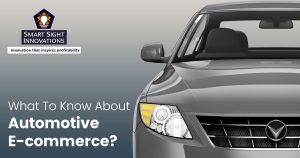 The rapid advancement of new technology, financial sustainability and changing consumer attitudes toward ownership are transforming economies significantly. Digitization and new approaches to business have revolutionized many industries, including the automotive industry and shopping online undoubtedly is the future of this industry.
The rapid advancement of new technology, financial sustainability and changing consumer attitudes toward ownership are transforming economies significantly. Digitization and new approaches to business have revolutionized many industries, including the automotive industry and shopping online undoubtedly is the future of this industry.
2021 saw a startling 61% of American automobile buyers willing to do their shopping online and by 2029, the global automotive e-commerce market is projected to reach USD 213 billion.
What Is Automotive E-commerce?
Automotive e-commerce is the online purchasing and selling of automobiles and their parts using a variety of tools like mobile tablets, PCs and phones. To sell both autos and auto parts effectively, the auto industry has changed its approach in favor of an online business model.
Automotive industry giants like Ford are promoting their e-commerce websites and social media presence by redesigning and prioritizing practicality and digital ads. Tesla too is a great example of how future automobile e-commerce sales may operate.
The Model 3 of Tesla was exclusively offered online when it debuted. Customers had the option of picking up their new vehicle at the nearby Tesla dealership or having it delivered to their residence. Tesla was able to sell more electric automobiles with this business strategy.
How Is E-commerce Important in the Automotive Industry?
The automotive e-commerce sector is expanding worldwide with digitalization and rising vehicle sales. Customers are slowly moving away from manual to semi-automated and automatic vehicle operations. Technological advances are another aspect that is anticipated to fuel market expansion.
Additionally, the age of automobiles is a factor in the expansion of the global automotive e-commerce market, which has increased demand for automotive parts and components. Price transparency, a more convenient shopping environment and many online offers have also triggered online purchasing.
Benefits of Automotive E-commerce
Automotive firms have seen an enormous transition as a result of e-commerce, not just in terms of their ability to reach new markets but also in terms of how they view their supply chain. The advantages of automotive e-commerce sites are considerable, for both consumers and automotive companies and they can aid in boosting sales throughout the entire value chain.
1. Simplify Processes and Cut Costs
Car dealers guide prospective clients through the entire buying process in person at physical stores, making dealerships spend a lot of time and money on this. Instead, firms can use automotive e-commerce along with digital marketing to help buyers in their purchasing journey. The four steps of a buyer’s journey include:
- Awareness (whenever customers search for information)
- Consideration (when they’re thinking about particular products)
- Purchase (when they decide to purchase)
- Loyalty (when they are dependable and likely to make more purchases)
Allowing buyers to purchase online can save you inventory costs as you do not have to stock every automobile on the lot. You just need to collaborate with an automotive e-commerce company and offer vehicles that can be ordered on demand.
2. Omnichannel Operations
Adopting an omnichannel strategy in your marketing, sales and service plans has many advantages.
- With an omnichannel retail, marketing or service plan in place, your team or your products are only a click, an email, a direct message or a phone call away.
- It will be much simpler for consumers to find your goods across a variety of channels and platforms, thus increasing profits.
- Customers receive the same service regardless of the platform or method they select.
- As customer satisfaction is the key, knowing they have multiple ways to contact your sales and customer support, will give them a sense of assurance.
3. Market Base
As customers are becoming increasingly comfortable purchasing vehicles online, a robust e-commerce platform can help boost your dealership. It removes geographical restrictions and permits sales in different locations.
Offering components and automotive products in numerous languages, various currencies and location-specific payment choices make it simple to expand into new markets and segments.
You no longer have to confine yourself to a particular state, city or county and can generate leads and close sales in places that would have been difficult to reach with a conventional dealership. You can also work on the delivery service, by determining how far your dealership can actually move cars and accordingly broaden your business into new, unexplored markets.
4. Customized Experience
Automotive businesses are better equipped to shape their customer experiences in a way that is universal and less vulnerable. A business can enhance the purchasing experience through an e-commerce platform by adding features like a customized e-commerce site or independent stores.
Organizations can assist consumers in finding the car or automotive parts they need by directing them on the proper path through digital and targeted advertising. Customers can browse product information and product pages, examine cars while comparing brands and even order car parts.
Top Automotive E-commerce Stores
Here are some auto companies committed to delivering exceptional customer experiences through e-commerce, by developing online solutions, which eventually increase market share, sales and revenue.
- Autoplicity (online store for auto parts)
- Enjuku Racing
- Sportbike Track Gear (sports bike and aftermarket equipment and gear)
- Warn Industries
- Auto Furnish
- Volvo Cars Collection (retail support cycle)
- BB Wheels
- Indianapolis Motor Speedway
- CruiseMaster
- Motoruma
- Metal Tech 4X4 (off-road vehicle parts)
- Awesome GTI (marketplace for auto parts and garage services)
- RTW Wheels (large wheel and tire company)
How To Generate Online Sales for Your Automotive E-commerce
E-commerce is beginning to emerge as a replacement for conventional retail in the auto sector. A user-friendly automobile website must prioritize the thoroughness of product presentation and ease of browsing. Some best essential components to put into practice are:
1. Design Principles
A product page should include manufacturing specifications and high-resolution photos (preferably with a 360-degree view option) in addition to the product description. A video may sometimes sell a product more effectively than an image.
2. Sorting and Searching
Customers should be able to rapidly sort and search through products while browsing, allowing them to find their items quickly and also compare products based on the price, manufacturer, model, make, etc.
3. Product Reviews
Digitally savvy consumers first read ratings, reviews and other types of feedback before purchasing online. Providing these on your website will prevent visitors from leaving and help them learn more about a certain product’s reputation, quality and affordability.
4. Mobile Presence
Many people use mobile devices to look for information such as searching for auto parts while maintaining or fixing a vehicle in the garage. You should give users features like menus and buttons, images and other enhancements to create a seamless experience.
5. Digital Showrooms
Businesses can combine the benefits of traditional dealerships and e-commerce stores with a virtual showroom. Automotive businesses can instantly bring vehicles to life by combining eye-catching pictures that highlight the appearance with technical details.
6. Social Media
Social media is constantly influencing society in the modern era. Businesses can advertise their products and encourage participation by setting up pages on various social media platforms like Facebook, Instagram, Twitter, and TikTok.
Although modernizing and digitizing a conventional dealership can seem challenging, the benefits of automotive e-commerce outweigh it. It enables your dealership to expand its customer base, save operating expenses, personalize the customer experience, give customers more power and help you close more sales.














